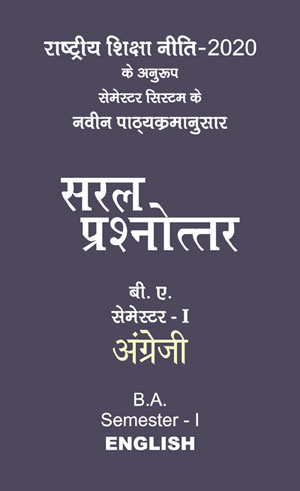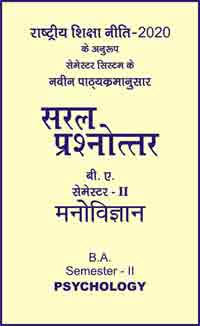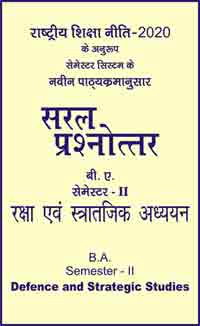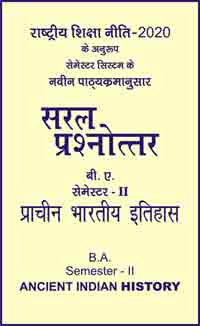|
बी ए - एम ए >> बीए सेमेस्टर-1 अंग्रेजी बीए सेमेस्टर-1 अंग्रेजीसरल प्रश्नोत्तर समूह
|
5 पाठक हैं |
|||||||
बीए सेमेस्टर-1 अंग्रेजी के प्रश्नोत्तर
2
Elements of Short Story
Question- Explain Plot in a Short Story.
Ans-
Every published short story has a plot- a story with a series of casual events that includes a beginning, middle, and end. Every good short story includes motive, conflict, climax, and resolution-the essential components of a short story. Without plot, the writer has not crafted a short story. The following aspects of plot:
• Definition
• Narrative Arc or plot structure
• Story versus Plot
• Components of a story
Definition of Plot
It is the series of events that make up the story, in which there is a beginning, middle, and end. Each story has its own unique plot. In Jack London's "To Build a Fire", there are a series of casual events that the protagonist must face while he treks through the Yukon wilderness. In James Joyce's "Eveline", the heroine thinks about a series of events that took place in the past, while attempting to make a decision about love. The final event ends the story-she decides to not get on the ship that will sail away to a new life with her love.
There are two types of plot that a writer can create. The first type is a unified plot. The story is realistic, includes a central character and action, and takes place in a single place, usually during a short span of time, such as an hour, few hours, a day. For instance, Ernest Hemingway's "Hills Like White Elephants" is a short story based on a conversation that takes place on a single day.
The second type of plot that a writer can craft is the episodic plot. The story has a setting central character, conflict, takes place over a much longer period of time. Often the writer will use the technique of "flashback" to provide background details or to tell the story. For instance, Margaret Attwood's "Death by Landscape" tells a tale that goes from childhood to middle age.
Plot is also the movement in time, movement in casualty, and movement in dramatic tension. How is plot a movement in time? A short story takes place during a particular span of time-such as a conversation, hour, few hours, day, week, or much longer. During the time frame, the central character is motivated to achieve some purpose will confronting or being confronted with conflict and/or obstacles.
A short story is based on a series of casual events, one after another. So, the writer must craft a story that is based on cause and effect. The first event triggers the second event. The second event triggers the third event, and so on. If the writer introduces a particular event, it must have a casual relationship to a previous event.
Read any short story, and we will see that the writer dramatizes events, inspiring the reader to turn the page and read on. To dramatize a story, the writer must use the technique of "show, don't tell." He/she crafts a dramatic scene to ratchet up the tension. A scene includes a location, dialogue, action, vivid details, and concrete and specific description. Short stories often include several scenes, each becoming more dramatic-until the climax or turning point of the story, the scene that contains the most tension. The writer also deploys show, don't' tell to crafts short story that includes conflict, obstacles, suspense. The writer might also include foreshadowing, flashback,epiphany.
Narrative Arc of a Short Story
Every short story has a narrative arc or plot structure. The narrative arc has the following components:
Inciting incident
• Rising action or plot complication
• Climax or turning point
• Resolution.
The writer begins the short story with an inciting incident-an event, action, decision that creates conflict, tension, unrest in the life of the central character, who is motivated or who desires to take action to achieve some particular purpose. In Hemmingway's, "Hills with White Elephants", the inciting incident is the unplanned pregnancy. In Tobias Wolff's "Bullet to the Brian", the story also begins with an inciting incident: "Andres couldn't get to the bank until just before it closed, so of course the line was endless..."
Often, the writer deploys a narrative hook to share the inciting incident with the reader. For instance, in Susan Minot's "Lust", she begins with a hook and inciting incident: "Leo was from a long time ago, the first one I ever saw nude."
Next, the writer introduces the rising action or one or more plot complications. The writer introduces a 'conflict-man against himself, man versus nature, protagonist against antagonist, a spiritual conflict, and so forth. The writer can also introduce obstacles, which prevent the central character from achieving his goal or purpose. For instance, in Jack London's "To Build a Fire", the traveler, who is the central character in the story, faces several obstacles while attempting to hike through the snowy bush to the camp site--bone chilling cold, deep snow, frostbite, falling through the ice, snow falling on the camp fire, exhaustion, anxiety, and the inability to restart the fire with matches.
-After introducing the plot complication or rising action, the writer crafts the turning point or climax. This is the point of the story with the most tension and most exciting event in the series of events that make up the story. The central character might face his/her enemy, make a decision, find a solution, experience an epiphany, or change in perception. In Margaret Attwood's "Death by Landscape", the turning point occurs when the supporting character disappears on a canoe trip. In William Faulkner's "A Rose for Emily", the turning point occurs when the central character, Emily, buys rat poison, which she will use to kill her lover/companion, Homer Barron, after he decides to end the relationship.
After introducing the turning point, the writer brings resolution to the story. The writer can end a story with an open or closed ending. When the story ends with a closed ending, the writer resolves the story by answering unanswered questions explicitly stated or implied in the story. Sometimes the story ends with a death. Jack London ends "To Build a Fire" with the death of the central character. William Faulkner ends "A Rose for Emily" with the death of the main character. The writer can end the story with an open ending: "Resolution is the end of the story, but it is not necessarily The End." (On Writing Short Stories by Tom Bailey) When the writer crafts this type of ending, the reader is left to wonder or surmise what happens next, after the story has ended.
Plot versus Story
What is the difference between plot and story? Strictly speaking, the story is the series of related events that make up the story. The plot of the story, on the other hand, asks why? It includes the motive of the main character to take action or to react. And this motive helps to create meaning or theme, which enables the reader to talk about what the story says about the human condition.
Components of a Short Story
In "On Writing Short Stories", by Tom Bailey, he discusses the components of a short story-which is similar to the narrative arc or plot structure. He suggests that there is no plot structure, only components that are crafted, molded into a short story. These components include:
• Motivation: the desire of the central character to take action, to react.
• Conflict: man against nature, man against man, man against society. Climax the highest point of tension, most intense action, turning point of the story
• Resolution: the story ends.
In summary, all short stories require a narrative arc or the components of a short story: motivation, conflict, turning point, resolution. Without these components, you have not written a complete short story.
|
|||||
- Question- Discuss Sri Aurobindo's contribution to Indo-Anglian poetry.
- Question- Discuss Sri Aurobindo as a mystic poet.
- Question- "Tagore is a lyric poet par excellence." Comment.
- Question- "Tagore is not a poet of Bengal, but of India and the world." Discuss.
- Question- Write a note on life and works of K. S. Venkataramani.
- Question- Describe Venkataramani's reflection on village life which he presented in his novels.
- Question- Write the life and writing style of Bhabani Bhattacharya.
- Question- Write about Bhattacharya's concept of Fiction.
- Question- Consider R. K. Narayan as a novelist.
- Question- Describe Indianess in R. K. Narayan's novels.
- Question- Write a note on Mulk Raj Anand's place in English Literature.
- Question- Write a note on the main influences on Mulk Raj Anand.
- Question- What is Mulk Raj Anand's contribution to the development of Indo-Anglian fiction?
- Question- What are the general themes of the novels of Mulk Raj Anand?
- Question- Write a short note on Mulk Raj Anand as a social critic of downtrodden society.
- Question- What is the contribution of Mulk Raj Anand to Indian English Literature?
- Question- Write a detailed life-sketch of Sarojini Naidu. Also describe in her works and contribution towards Indian Writing English.
- Question- Write life and career details of Kamala Markandaya in detail.
- Question- Write a note on the contribution of Kamala Markandaya towards the growth of Indian English Literature.
- Question- Write a comment on Kamala's 'Art of Narration".
- Question- Write a note on life and works of Nayantara Sahgal.
- Question- Write a list of the works of Nantara Sahgal?
- Question- Which is the last novel of Nayantara Sahgal?
- Question- Explain Plot in a Short Story.
- Question- What is characterization in a short story? Discuss the types & importance of characterization.
- Question- What is the meaning of Narrative Techniques? Explain types of narrative technique with examples.
- Question- Write a note on the Narrative structure and its types. Discuss in brief.
- Question- What is prose and what types of prose are found in English Literature?
- Question- What is short story?
- Question- What is an essay?
- Question- Discuss novel.
- Question- What is autobiography?
- Question- What is biography?
- Question- What is play?
- Question- What is Travelogue ? Mention two books that belong to this class of literature.
- Question- Discuss Pamphlet.
- Question- What is biography? Name two famous biographies in English.
- Question- What is an informal essay? Who is a well-known informal essayist of English Literature?
- Question- Distinguish between formal and personal essay. Give examples.
- Question- How would you distinguish between early eighteenth century and early nineteenth century style in literary essay writing?
- Question- What is an autobiography? How is it different from a biography?
- Question- What is theme? Explain in detail.
- Question- What do you know about Sentence Pattern?
- Question- What do you know about Imagery and Explain the types of Imagery?
- Question- What is Tone or Mood? Elaborate it in detail.
- Question- What is the definition of 'Point of View' ?
- Question- What do you understand by Humour ? Also write the characteristics and kinds of it.
- Question- What is the meaning of Analogy?
- Question- What do you mean by Anecdotes?
- Question- What do you mean by Aphorism?
- Question- What are the definitions of Inversion?
- Question- How do you define a theme?
- Question- What is the theme in a story?
- Question- What are the main themes?
- Question- What is imagery and its example?
- Question- Define Pathos in literature.
- Question- What are the origins of Pathos ?
- Question- What is Pathos?
- Question- What are the models of humour?
- Question- What do you mean by Antithesis?
- Question- What do you mean by diction?
- Question- O. Henry's The Last Leaf is the story of perseverance. Discuss.
- Question- Describe the character of Sue in the story 'The Last Leaf.
- Question- How does Johnsy deals with her illness?
- Question- Explain the theme and the title of the story "The Last Leaf."
- Question- Attempt a detailed character sketch of Iona.
- Question- Comment on the setting, theme and tone of the story.
- Question- What message does the story 'Lament' provide?
- Question- Analyse the story with reference to its relevance in the present context.
- Question- Comment on the symbolism in the short story "The Lament'.
- Question- Who is Iona ? What impression of his character do you get from the story?
- Question- Why is it important for Iona to be able to tell someone about his son's death?
- Question- Comment on the indifference that meets Iona's attempts to share his grief with his fellow human beings.
- Question- How does the horse serve as a true friend and companion to Iona ?
- Question- Empathy and understanding are going out of modern society. The individual experiences intense alienation from the society around him or her. Comment.
- Question- Explain in detail the life and work of Guy de Maupassant.
- Question- What is the summary of the story The Terror' by Guy de Maupassant?
- Question- What is the theme of the story The Terror' and describe it in your own words?
- Question- Write the Introduction of the story The Terror'.
- Question- What is the point of view in this story "The Terror' by Maupassant?
- Question- What is meaning of 'Fear' and 'Sense' in this story The Terror?
- Question- What is in Mental Disorder in this story The Terror'?
- Question- The writer presents his attitude towards women in this story "The Terror'. Explain it.
- Question- What is the summary of the story The Barber's Trade Union' by M. R. Anand.
- Question- Who is the Protagonist of the stoey The Barber's Trade Union"?
- Question- Why was Chandu not good at doing sums at school?
- Question- Why did the narrator's mother constantly dissuade him to play with Chandu?
- Question- What is the meaning of Trade Union?
- Question- What is the summary at the story 'Under The Banyan Tree' by R. K. Narayan?
- Question- Describe the village Somal.
- Question- Who is Nambi in the story 'Under the Banyan Tree' ?
- Question- What do you understand by 'enchanter"? Why does the author call Nambi an 'enchanter"?
- Question- What is irony? How does Narayan use it in this story?
- Question- "It was story building on an epic scale." What do you understand by this statement? Elaborate.
- Question- Why does Nambi says, "...... Age, age. What is my age? it has come on suddenly ?"
- Question- Describe Nambi's life after he stops telling stories? Do the villagers reject him?
- Question- Explain "terrible sense of his insignificance" which Ravi feels at the end of the story. What lesson has he learned about life?
- Question- Discuss the various themes in the story.
- Question- Comment on the plot of the story.
- Question- Attempt a detailed character sketch of Ravi.
- Question- What do you know about the setting of the story, 'Games At Twilight'?
- Question- Who is Raghu ? What do you assess about his character?
- Question- Describe the garden in which the children are playing hide and seek.
- Question- What are your impressions of the following children from the first section of the story?
- Question- How is the shed described? Why are these details important to understanding Ravi's feelings?
- Question- How did Ravi lose without being caught?
- Question- Analyse the theme of Bacon's eassy 'Of Studies.'
- Question- Write an essay on Bancon's prose style.
- Question- Critically appreciate Bacon's 'Of Studies'.
- Question- What message does Bacon try to put across in the essay 'Of Studies'?
- Question- The essays of Bacon are concerned only with worldly wisdom and the art of success. Discuss.
- Question- What type of books are recommended by Bacon for studies?
- Question- What are the bad effects of studies according to Bacon?
- Question- How does Bacon justify that various defects of mind can be cured by particular studies?
- Question- Who is the author of 'Of Studies'?
- Question- According to Bacon what is the use of studies?
- Question- How studies are used by different kinds of people?
- Question- Bacon says 'Studies pass into character', explain it.
- Question- Give two features of Bacon's style.
- Question- Quote one sentence Bacon's 'Of Studies', that you like most.
- Question- Ennumerate the advantages of reading books.
- Question- Give two reasons why do you like an essay.
- Question- How, according to Bacon, do history, poetry, mathematics, natural philosophy, moral philosophy and logic and rhetoric help one to improve one self?
- Question- Write a brief note on the life and work of Charles Lamb.
- Question- Give a critical estimate of Lamb as an essayist.
- Question- What are the salient features of Lamb's prose-style?
- Question- Discuss autobiographical element in the essays of Lamb.
- Question- Write a note on Lamb's as a writer of humour and pathos.
- Question- Write a note on Lamb as a lover of peace.
- Question- What happened when Lamb awakened from his dream?
- Question- How does Charles Lamb present his brother John Lamb?
- Question- Examine in short "Dream Children" as a specimen of Dream Literature.
- Question- Analyse the striking qualities of Addison as a satirist ?
- Question- Compare Addison and Steele as critics of the life and manners of their age.
- Question- Write a note on Addison's prose style.
- Question- Briefly analyse Addison's prose style.
- Question- Who was Sir Roger?
- Question- Why is said that Sunday clears away the rest of the whole week?
- Question- Write a note on use of wit, irony and fancy in the essay of Addison?
- Question- What is the significance of a Country Sunday?
- Question- Give a brief note on Addison as a innovator of periodical essays.
- Question- Who is the author of the essay 'Sunday in the Country'.
- Question- Give an introduction of 'Profession For Women' by Virginia Woolf.
- Question- Critical appreciation to 'Profession For Women' by Virginia Woolf.
- Question- What are the main obstacles in Profession For Women' by Virginia Woolf?
- Question- What is the main point of the essay Profession for Women'?
- Question- Describe the full life detail of A.P.J. Abdul Kalam.
- Question- Write about the famous book "Ignited Minds" of Kalam and its qualities.
- Question- What is an early life and education of Amartya Sen?
- Question- What do you know about Amartya Sen's Career?
- Question- What do you know about Amartya Sen's personal life?
- Question- Write about Amartya Sen's award and honours.
- Question- Give an Introduction to The Argumentative Indian', written by Amartya Sen, in your words.
- Question- How does Amartya Sen portray Tagore in his essay Tagore and His India"?
- Question- What did Rabindranath Tagore do for India?
- Question- What do you mean by Power Point Presentation?
- Question- What are benefits of Power Point?
- Question- Discuss power point presentation.
- Question- What is presentation? How are they created?
- Question- Give the importance of letter writing. What are the types of letters? What are the qualities of a good letter?
- Question- Make an application to the Principal P. P. N. College Kanpur for giving you a full concession in fee.
- Question- Write an application to the Principal of your college requesting him to allow you to change one of your subjects.
- Question- Write an application to the District Supply Officer for supplying building material.
- Question- Write an application to the Principal of your college requesting him to grant you leave for four days so that you may attend the marriage ceremony of your elder sister.
- Question- Discuss personal letter. Name the parts of it.
- Question- What do you understand by an Inquiry letter?
- Question- What is complaint letter and also describe the format and examples of it.
- Question- Describe Right to Information letters in detail and also tell the steps to file it.
- Question- Write a note on enquiries, quotations and orders.
- Question- Write a note on complaint and adjustment letter.
- Question- Give the form and contents of an application letter.
- Question- Discuss Resume writing.
- Question- Write down the do's and dont's while preparing your resume.
- Question- Write a note on covering letter of resume.
- Question- Write short note on the following- (a) Bio-data (b) Application blanks.
- Question- Pen down a model of an application to the Vice Chancellor of a University for the post of Assistant Professor of Education.
- Question- Write a detailed note on Online Writing.
- Question- What is a Blog?
- Question- What are the purpose of a blog?
- Question- What is Blog Structure?
- Question- What is blogging?
- Question- What is Content Writing?
- Question- Write the types of Content Writing.
- Question- What is the basics of content writing?














